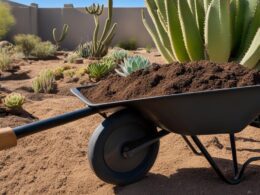In today’s world of increasing environmental concerns, water conservation has become a top priority. One effective technique that can make a significant impact is mulching. By utilizing the right mulching techniques, you can conserve water and improve soil moisture in your garden. This article will guide you through the various mulching techniques that promote water efficiency and help you save water.
Key Takeaways:
- Mulching is a powerful technique for conserving water in your garden.
- By using the right mulching techniques, you can reduce evaporation and enhance moisture retention.
- Mulching with organic amendments, such as pine straw or bark, can improve water efficiency in your landscape.
- Proper watering and avoiding disturbance of established plants are essential for maintaining a water-efficient landscape.
- Implementing mulching techniques can create a sustainable and water-efficient landscape.
Planning the Landscape for Water Conservation
When it comes to water conservation, proper planning of your landscape is essential. By strategically selecting plants based on their water needs and sunlight requirements, you can optimize water usage and reduce waste. Grouping plants with similar water and light requirements together allows for efficient irrigation and ensures that each plant receives the appropriate amount of water.
Understanding the water needs of different plants is crucial in designing an effective irrigation system. Some plants, like succulents, have low water needs and can thrive in drier conditions, while others, such as certain types of grass, require more frequent watering. By categorizing plants into different irrigation zones, you can tailor your watering schedule to meet each zone’s specific needs.
Testing the soil and making necessary amendments also play a significant role in water conservation. By understanding the soil’s composition and pH levels, you can improve its structure and promote efficient water movement. Adding organic matter, like compost, can enhance the soil’s ability to retain moisture and reduce the need for excessive watering.
Exploring alternative methods of obtaining water can further contribute to water conservation efforts in your landscape. Rainwater harvesting, for example, involves collecting rainwater in barrels or tanks and using it for irrigation. This reduces reliance on traditional water sources and helps conserve water for periods of drought or water scarcity.
Table: Plant Water Needs and Irrigation Zones
| Plant | Water Needs | Irrigation Zone |
|---|---|---|
| Succulents | Low | Zone 1 |
| Xeriscaping Plants | Low to Moderate | Zone 1 |
| Native Grasses | Moderate | Zone 2 |
| Flowering Shrubs | Moderate to High | Zone 2 |
| Tropical Plants | High | Zone 3 |
By planning your landscape for water conservation and implementing these strategies, you can create a sustainable and water-efficient outdoor space that not only benefits the environment but also saves you money on water bills.
Proper Planting Techniques for Water Conservation
Proper planting techniques are essential for water conservation in your landscape. By incorporating organic amendments into the soil, promoting root growth, and utilizing water-absorbing gels, you can create a more water-efficient garden.
Soil Amendments
Adding organic amendments, such as compost, to the soil can greatly improve its structure and enhance its ability to retain moisture. This results in healthier plants that require less irrigation. The organic matter in the soil helps to create pore spaces, allowing air and water to penetrate more easily and preventing water runoff. Before planting, mix compost into the top few inches of soil to provide a rich environment for root development.
Root Growth
Roots play a crucial role in water absorption and overall plant health. By promoting strong root growth, you can increase the water-holding capacity of your soil. Loosening the soil before planting helps roots penetrate more easily and access water deep within the ground. Water-absorbing gels can also be beneficial in drought-prone areas. These gels absorb and retain water, releasing it slowly to the plant roots. Mix the gel granules with the soil or place them directly in the planting hole to provide a reservoir of moisture for the roots.
Mulching
Mulching is an effective technique for conserving moisture in the soil and reducing the need for frequent watering. A layer of mulch helps to suppress weed growth, regulate soil temperature, and prevent evaporation. One popular mulching option is pine straw, which is lightweight and easy to spread. Pine bark or shredded hardwood mulch are also excellent choices. Apply a layer of mulch around newly planted trees, shrubs, and flowers, making sure not to place it directly against the plant stems. Aim for a thickness of 2 to 3 inches to maximize moisture retention.
By implementing these proper planting techniques, you can significantly reduce water usage in your landscape while still maintaining healthy and thriving plants. Remember to select plants based on their water needs, and always consider the specific conditions of your garden when determining appropriate watering schedules. With these strategies in place, you can create a beautiful and water-efficient landscape that benefits both the environment and your wallet.
Managing the Landscape for Perpetual Water Savings
Proper management of your landscape is crucial for achieving perpetual water savings. By understanding and addressing factors such as water stress, irrigation timing, fertilizer usage, and mulch maintenance, you can significantly reduce water consumption and contribute to a more sustainable environment.
Water Stress
Recognizing the signs of water stress in your plants is essential for efficient irrigation. Look out for wilting foliage or abnormal leaf color, as these are indications that your plants are not receiving adequate water. Monitoring the moisture levels in the soil can also help you determine when to water. By avoiding overwatering or underwatering, you can ensure that your plants receive just the right amount of water.
Irrigation Timing
The timing of your irrigation plays a crucial role in minimizing water loss due to evaporation. It is recommended to water your landscape during the early morning or at night when temperatures are cooler. This allows the water to penetrate the soil effectively and reduces the risk of evaporation. Avoid watering during the hottest parts of the day, as this can lead to significant water loss without providing sufficient hydration to your plants.
Fertilizer Usage
Using fertilizers sparingly and targeting specific plants can help reduce water usage while still providing essential nutrients. Avoid excessive use of fertilizers, as this can lead to leaching, where nutrients are washed away by excess water. Instead, opt for slow-release fertilizers that gradually release nutrients over time, ensuring optimal absorption by your plants. By using fertilizers strategically, you can minimize water waste and promote healthy plant growth.
Mulch Maintenance
Mulching is an effective technique for conserving moisture in the soil, reducing weed growth, and maintaining soil temperature. Regularly check your mulch layer and ensure it is at the recommended thickness of 2 to 3 inches. Replace any mulch that has decomposed or thinned out to maintain its water conservation benefits. Additionally, avoid piling mulch directly against the stems of plants, as this can create a favorable environment for pests and diseases.
By implementing these management practices, you can achieve perpetual water savings in your landscape. Conserving water not only benefits the environment but also reduces your water bills and promotes the health and longevity of your plants.
| Water Conservation Practice | Benefits |
|---|---|
| Proper water stress management | Prevents overwatering or underwatering, reduces water waste |
| Optimal irrigation timing | Minimizes water loss due to evaporation |
| Strategic fertilizer usage | Reduces water usage while providing necessary nutrients |
| Regular mulch maintenance | Conserves moisture, controls weed growth, and maintains soil temperature |
How Does Mulching Help in Water Conservation in Gardens?
Effective mulching in low-water gardens is a simple and practical way to conserve water. Mulch helps to reduce the amount of water lost through evaporation, suppresses weed growth, and improves soil structure. By retaining moisture in the soil, mulching can significantly reduce the need for irrigation in gardens, leading to water conservation.
Conclusion
Mulching techniques are essential for water conservation and maintaining soil moisture in your garden. By implementing proper mulching techniques, you can significantly reduce water evaporation and save water. It is crucial to select the right plants, test the soil, explore alternative water sources, and use organic amendments to enhance the effectiveness of mulching.
Managing the landscape is equally important in perpetuating water savings. Understanding the signs of water stress, timing irrigation appropriately, and maintaining mulch layers all contribute to conserving water. By following these practices, you can create a sustainable and water-efficient landscape that benefits both the environment and your home.
Remember, mulching helps conserve moisture, control weed growth, and maintain soil temperature. It is a simple yet powerful technique that can make a significant difference in water conservation efforts. So, start incorporating proper mulching techniques today and contribute to preserving our precious water resources for a greener future.












